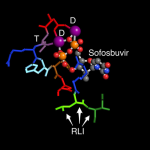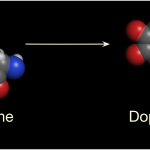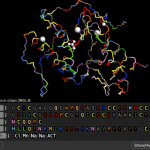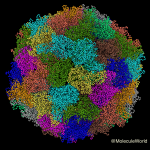molecular modeling
On Sept. 30th, I'm going to be co-presenting a Bio-Link webinar on Genome Engineering with CRISPR-Cas9 with Dr. Thomas Tubon from Madison College. If you're interested, Register here. Since my part will be to help our audience understand the basics of this system, I prepared a short tutorial with Molecule World . Enjoy!
A Quick CRISPR Tutorial
Go to the Digital World Biology CRISPR Structure Collection.
Download the second item in the list, 5F9R, by clicking the link in the Download structure column.
Identify the three components of the CRISPR - Cas system: …
It's well understood in science education that students are more engaged when they work on problems that matter. Right now, Zika virus matters. Zika is a very scary problem that matters a great deal to anyone who might want to start a family and greatly concerns my students.
I teach a bioinformatics course where students use computational tools to research biology. Since my students are learning how to use tools that can be applied to this problem, I decided to have them apply their new bioinformatics skills to identify drugs that work against Zika…
"By night all cats are gray" - Miguel Cervantes in Don Quixote
I've always liked Siamese cats. Students do, too. "Why Siamese cats wear masks" is always a favorite story in genetics class. So, when I opened my January copy of The Science Teacher, I was thrilled to see an article on Siamese cat colors and proteins AND molecular genetics (1).
In the article, the authors (Todd and Kenyon) provide some background information on the enzymatic activity of tyrosinase and compare it to the catechol oxidase that causes fruit to brown, especially apples.…
Imagine a simple hike in a grassy part of South America. You hear a rattle and feel a quick stab of pain as fangs sink into your leg. Toxins in the snake venom travel through your blood vessels and penetrate your skin. If the snake is a South American rattlesnake, Crotalus terrific duressis, one of those toxins will be a phospholipase. Phospholipases attack cell and mitochondrial membranes destroying nerve and muscle function. Without quick treatment, a snakebite victim may be die or suffer permanent damage (1, 2).
The phospholipase from…
When my parents were young, summer made cities a scary place for young families. My mother tells me children were often sent away from their homes to relatives in the country, if possible, and swimming pools were definitely off limits. The disease they feared, poliomyelitis, and the havoc it wrecked were the stuff of nightmares. Children could wake up with a headache and end up a few hours later, in an iron lung, struggling to breathe.
Poliovirus colored by molecule in Molecule World.
…
Sucrose
Molecules of sucrose tore apart in their bellies letting glucose course free in their veins.
Luckily for us, a system evolved long ago to capture that glucose and minimize it's potential for damage. Removing sugar from the blood and sequestering it in liver, fat, and muscle cells, minimizes the harm that might result if sugars were free to bind to proteins and our bodies were stressed by trying to flush excess glucose out of our system.
This holiday season, we give thanks for insulin and the biotech companies like Genentech that cloned the human gene and began to…
Instead of enjoying a sunny summer day today, or partying with SciBlings in New York, I'm staring out my window watching the rain. Inspiration hit! What about searching for August?
Folks, meet the HFQ protein from E. coli. I found this lovely molecule by doing a multi-database search at the NCBI with the term 'August'.
HFQ is a lovely protein with six identical subunits, that's involved in processing small RNA molecules and is homologous to some eucaryotic proteins that work in RNA splicing (1).
Do you see the blue loopy regions in the center of the structure? Those are positively…
I added the spring colors.
Two protein structures from an avian influenza virus are shown below. One form of the protein makes influenza virus resistant to Oseltamivir (Tamiflu®)
Don't worry, these proteins aren't from H5N1, but they do come from a related influenza virus that also infects birds.
technorati tags: molecular models, protein structures, influenza, bioinformatics, Cn3D
One protein structure is from a strain that is sensitive to an anti-viral drug called "Tamiflu®". The other structure is from the same virus, except there's a slight difference. A single base change in the viral RNA changed the codon that…
Although, I certainly didn't believe it. Truly in nature, it can be described as nonpareil.
With all the years that I've heard (or taught) that all DNA is antiparallel, it was hard to believe my own eyes when I saw this structure.
Yet here is, on the screen, parallel DNA.
The image that I posted a couple of days ago came from this same structure. In that image, I hid the rest of the bases, to make it easier to see why this structure is so strange.
Here are some images that show the landmarks a bit better. I hid the hydrogens and used different rendering styles to portray the backbone and the…





